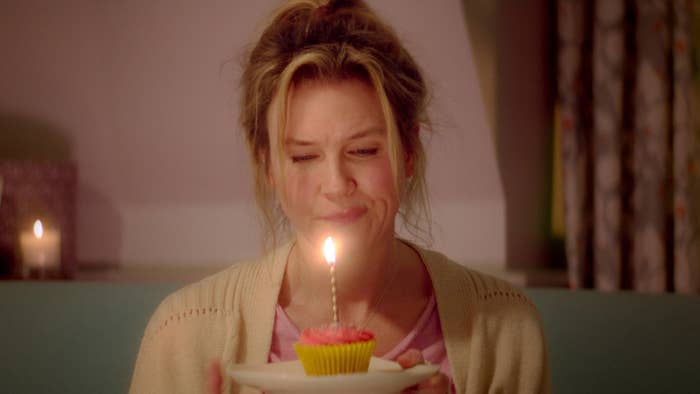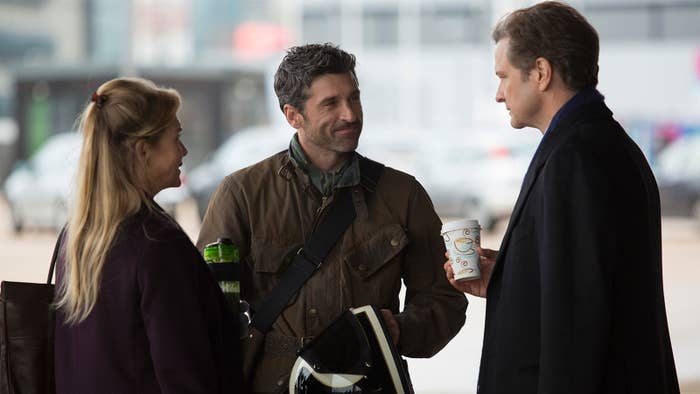
The opening scene of the new movie Bridget Jones’s Baby (out Sept. 16) will look familiar to anyone who has encountered our heroine in one of her two previous big-screen outings (2001’s Bridget Jones’s Diary and 2004’s Bridget Jones: The Edge of Reason). Bridget (Renée Zellweger) is alone in her apartment on her 43rd birthday and about to eat a cupcake while the song “All by Myself” wails. “How in hell did I end up here again?” she asks, which is a question that we too might be wondering. Bridget is — still! — a professional Sad Single Lady; she remarks that she got her annual phone call from her mother to remind her to take her ovaries out of retirement, but "at least I was down to my perfect weight."
If this all sounds familiar, that's because this has been Bridget's refrain since the first movie, when she lamented, "That was the moment I suddenly realized that unless something changed soon, I was going to live a life where my major relationship was going to be with a bottle of wine. And I’d finally die, fat and alone, and be found three weeks later half eaten by wild dogs."
The tropes will get you every time. It's barely a spoiler (since it's in the trailer) to learn that in Baby, there's a wedding at the end of the movie. As decades of rom-coms have taught us, it's impossible to portray singledom as anything besides an extended pit stop on the journey to wedded bliss. But in the age of single-lady empowerment books like Rebecca Traister's All the Single Ladies and Kate Bolick's Spinster, is it too much to expect that Bridget would possibly embrace a different path than the one that every rom-com trope requires?
Well...yes, probably. After her disastrous birthday — her best friends all bail on her birthday dinner for child-related reasons, and she's greeted at work by a cake loaded down by 43 candles — Bridget finds herself rolling around a yurt at a music festival with a sexy American played by Patrick Dempsey. But a week later, she's reunited with her one true love, Mark Darcy (Colin Firth), at a christening, and they too have sex. Then, of course, hijinks about which of these handsome, apparently virile men is the father ensue.

The movie is funnier than it needs to be — I laughed out loud several times at the screening I went to, and I was reminded just how good Zellweger is at physical comedy in particular. Still, I was left with the nagging feeling that — like Bridget at the beginning of the movie — the romantic comedy, as a genre, is also in a stage of arrested development. One of the characteristics of Shakespearean comedy was that they ended with a wedding (as opposed to tragedies, which ended in death). English novelists like Fanny Burney and Jane Austen wrote the first romantic comedy novels, which ended with weddings, and the genre has in large part not deviated from that narrative.
So Bridget’s trajectory from sad-sack single lady to happily married woman with a child reflects a traditional, predictable, heteronormative romantic comedy storyline. Few big-budget Hollywood rom-coms have dared subvert that narrative; one that actually did was the Jennifer Aniston/Vince Vaughn film The Break-Up, which ends (spoiler alert for a 10-year-old movie) with Aniston and Vaughn's characters going their separate ways. But in general, the mainstream film industry has been slow to deviate from a script where marriage is seen not just as the goal, but as a sign of a fully actualized life. (Though indie films like (500) Days of Summer and Celeste and Jesse Forever have done a better job at challenging this narrative, and TV has also caught on with shows like You're the Worst, Better Things, and even The Mindy Project.) So are these predictable narratives what audiences actually want, or are they what Hollywood thinks audiences want?
In Bridget Jones's Baby, Bridget has come quite far professionally — she's the producer of a daily TV show called Hard News — but her fruitless dating life is what seems to dominate her identity, as it has since the first movie. Once the main story of Baby — which man is the father of her unborn child — gets set in motion, there's a brief moment when it seems like there could be a world in which Bridget would strike out on her own, but the story very quickly becomes not just about which man is the father, but also about which man she'll spend the rest of her life with. It's a subtle yet significant shift, one that closes the door on the possibility that Bridget will raise her child alone.
So when Bridget gets fired by her younger boss after a disastrous presentation of a new live broadcast app from Hard News, she's worried, but not too worried. After all, she has two handsome, successful men fighting over her. And while it's not clear what might have happened to Bridget professionally, the takeaway is that what she really wanted, at the end of the day, was to be married.
Like Carrie Bradshaw and Ally McBeal, Bridget Jones has long served as an avatar for a certain type of woman: professionally ambitious but unlucky in love, and alternately defiant and despondent about it. This Hollywood "type" has yet to evolve to embrace the nuances of how we live now. As Traister writes:
"Today’s women are, for the most part, not abstaining from or delaying marriage to prove a point about equality. They are doing it because they have internalized assumptions that just a half-century ago would have seemed radical: that it’s okay for them not to be married; that they are whole people able to live full professional, economic, social, sexual, and parental lives on their own if they don’t happen to meet a person to whom they want to legally bind themselves. The most radical of feminist ideas — the disestablishment of marriage — has been so widely embraced as to have become habit, drained of its political intent but ever-more potent insofar as it has refashioned the course of average female life."
The film even ends on Bridget with her new husband and baby — a perfect inverse of the beginning of the film, when she's sad and alone. The implication here is that for Bridget to become fully actualized, she has to commit herself to the most traditional of narratives, because otherwise, what is she? As Kate Bolick wrote in The Atlantic in 2011, in an article that would serve as the basis for Spinster: "The single woman is very rarely seen for who she is — whatever that might be — by others, or even by the single woman herself, so thoroughly do most of us internalize the stigmas that surround our status."
Of course, those stigmas are more complicated when you're not Bolick's (or Bridget's) demographic: white and upper-middle-class. Of single mothers, Bolick writes: "Today 40 percent of children are born to single mothers. This isn’t to say all of these women preferred that route, but the fact that so many upper-middle-class women are choosing to travel it — and that gays and lesbians (married or single) and older women are also having children, via adoption or in vitro fertilization — has helped shrink the stigma against single motherhood." Once rich white women decided it was okay to be single moms, then society came around too.
But again, the mainstream film industry has never been particularly groundbreaking when it comes to challenging social norms. (Trainwreck, which grossed $140 million worldwide, is something of an exception: a rom-com whose heroine is actually multidimensional, although the movie has a typical rom-com ending.) In pop culture, single moms in movies are usually some combination of poor and/or nonwhite and/or young — the implication being that they are for gawking, not relatability. For Bridget to end the movie happy and alone with her child would not have given audiences their satisfying rom-com ending, but it would have been a small but significant improvement in how single women are represented in popular culture.
The familiar structure of the rom-com may provide comfort, but in 2016 it feels unreflective and regressive. While there may not seem to be much incentive for Hollywood to take risks when it comes to the genre, the box office says otherwise — only two of the top 25 highest-grossing romantic comedies since 1978 are from the last five years (Silver Linings Playbook and Trainwreck). Perhaps audiences, too, have soured on a genre that has become rote and predictable.
This may be a sequel and a big Hollywood movie, but that doesn't mean we can't ask more from it. Zellweger has recently been quite vocal about the ways in which she feels that society focuses too much on older women's appearance and how they should age in public. Perhaps she, and we, can now turn our attention to the ways in which Hollywood resorts to old-fashioned ideologies and narratives that reinforce those very same issues.
